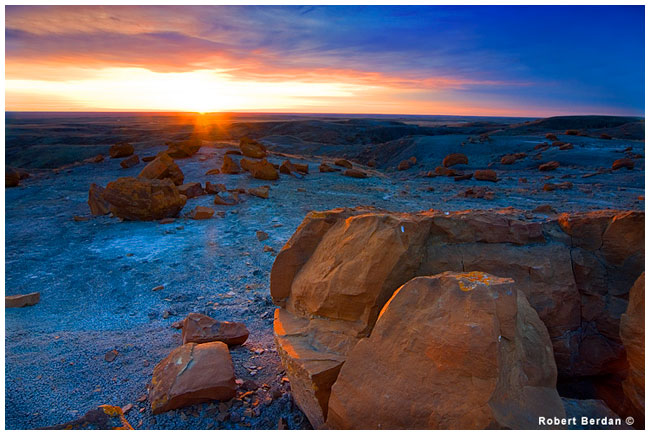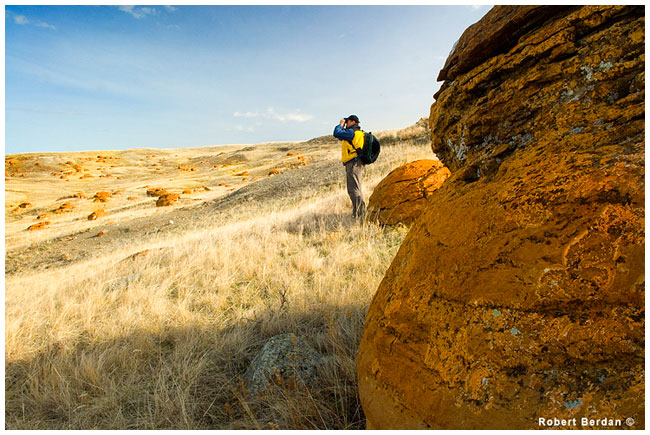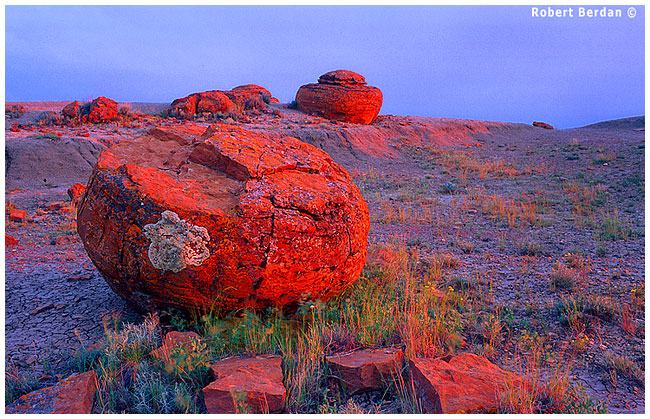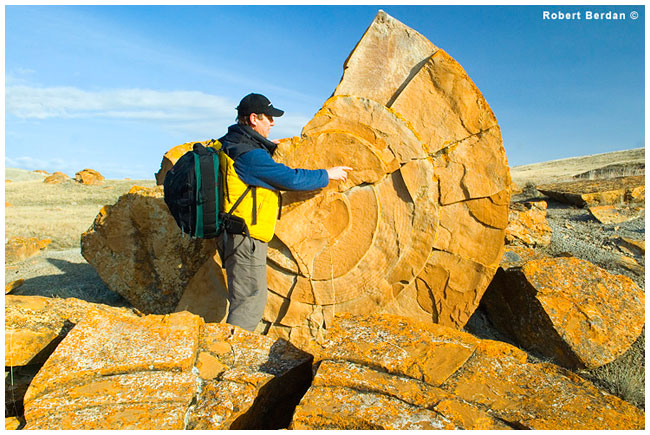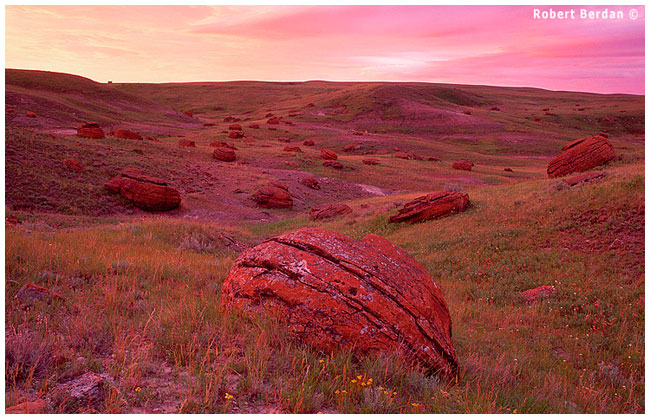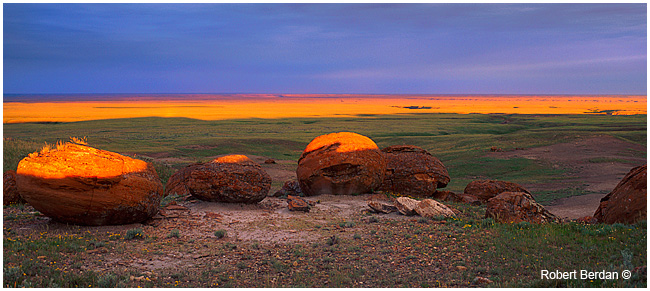
Red Rock Coulee in Southern Albertaby Robert Berdan
Red Rock Coulee is located about 50 km south west of Medicine Hat, Alberta, It offers one of the most unusual landscapes you will see anywhere and if there wasn't any grass you could just as well be visiting Mars. To get there take highway 3 from Medicine Hat to a small town of Seven Persons, then drive 26 km south on highway 887 until the road starts to curve east. There is a sign on the road indicating Red Rock Coulee - go straight ahead up a dirt road about 1 km until you come to a turn about. There are no facilities other then a single picnic table. The parking lot is situated at an elevation of 998 m and offers an impressive view of the coulee and surrounding prairie landscape. On clear days you can see the Sweet grass hills in Montana more the a 100 km away. If you are driving from Calgary it takes about 4 hours to get there.
Coulee is filled with red rock concretions - take away the grass and you have a Martian landscape Red Rock coulee consists of 324 hectares of Crown Land designated as a Natural Area. A coulee is a deep ravine or gulch that has been worn away by running water - though you won't find any bodies of water nearby. Red Rock coulee formed about 13,000 years ago and exposes 75 million year old bedrock called the Bearpaw formation. The coulee consists of badlands, eroded shale, bentonite and a few mixed grasses. The most conspicuous feature are large round red rocks some of them 2 meters in diameter or more. These red rocks are thought to be concretions that formed below a shallow sea. Concretions form when sand particles are bonded into layers around a nucleus like a bone, leaf or shell. Pearls are examples of modern concretions. If these are concretions they are among the biggest in the world. The rocks are also reddish-orange in colour due to the formation of rust (iron oxide and iron carbonate). The surface of the rocks are also covered with orange, black and gray lichens called Xanthoria and these lichens can withstand enormous temperatures ranges from -46 C in winter to 42 C in summer. The red colour of the rocks is emphasized by the warm glow of the sun at sunrise and sunset which are the best times take pictures.
The red colour of the rocks is amplified at sunset and sunrise It is possible to explore a good part of the coulee in half a day. Be sure to bring a good pair of hiking boots, lots of water, a hat and sun tan lotion in the summer. Generally it becomes too hot after about 11 am in the summer the best times to be there are around sunrise and a few hours before sunset. If it should start to rain head back to your car immediately or stay on the top grassy areas to avoid being trapped in the bentonite which forms a thick gumbo. The area only receives about 250-300 mm of precipitation so its considered a dessert. In spite of the inhospitable landscape there is an abundance of wildlife in the coulee including mule deer, Richardson's ground squirrel, coyotes, Pronghorn antelope, jack rabbits and variety birds such as common nighthawks, horned larks, lark bunting, grasshopper sparrows and western meadowlark. You will probably hear coyotes and nighthawks in the evening before you seen them.
Horned Lark on fence post - Red Rock Coulee, AB
Near the bottom of the coulee some of the rocks are still emerging as the softer soil is eroded around them. At the top of the coulee the ground is covered in short grass and hiking down into the coulee you will encounter juniper, sagebrush, evening primrose, ball cactus, prickly pear cactus, Wild Rose and Shining Arnica. In spring time prairie crocus are common in the grassy areas. There are no trees in the coulee.
Many of the large concretions are split in half and its possible to make out distinct rings inside some of them
East side of coulee is strewn with large red boulders. Photograph taken before sunrise.
Near the south end of the Coulee you will find rows of Red Rocks piled up one next to the other. What to bring to take photographs
Pronghorn Antelope - photographed in fields near Red Rock Coulee On an average summer day you might only encounter one or two other visitors, most visitors seem to be from nearby Medicine Hat. You can stay in a motel in Medicine and drive out in about 40 minutes or if you prefer to rough it you can set up a small tent or sleep in your car which I have done several times. In Spring and Fall the temperatures are likely to be cooler. I have yet to visit in winter but its a the top of my list of things to do. Remember to only take pictures and do not remove any of the rocks or fossils you might come across. Other then that do watch where you step as prairie rattlesnakes are found in the area though in my experience they are rare. . First light on Red Rock coulee Prairie rattlesnake (Croatalus viridis viridis) on bentonite. We found him on the main path down into the coulee so watch your step. See article "Prairie Expedition" for more photos of this prairie rattlesnake. Rattle snakes are rare in Alberta and considered and endangered or threatened species. Please do not kill a snake if you find one.
Sunrise at Red Rock coulee
Full Moon rise over prairie - from Red Rock Coulee parking lot.
Sunrise over Red Rock Coulee - from Parking lot
Photographer (my father) setting up on one of the large concretions
Medicine Hat is 265 Km from Calgary, and Red Rock coulee is about a 40 minute drive south west of Medicine Hat.
Red Rock pan photograph see VR movie below to pan around 360 degrees QuickTtime VR movie of Red Rock Coulee with a Friend (Keith Logan) standing beside one of the rocks. Drag Red Rock Coulee is one of the most beautiful landscapes I have photographed. It's not for everyone, but I love the large rocks, and the desert like features. I also like the fact that few people visit this area and those that do please be considerate and take your garbage home with you. Leave all rocks, fossils and animals as you found them. I hope my next visit will be in winter. Other useful links about Red Rock Coulee
[ Top ] |
